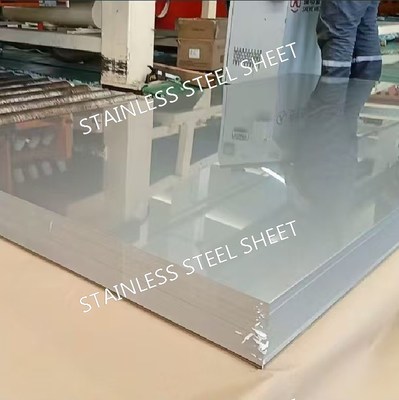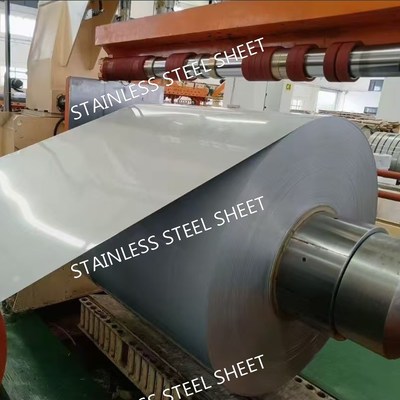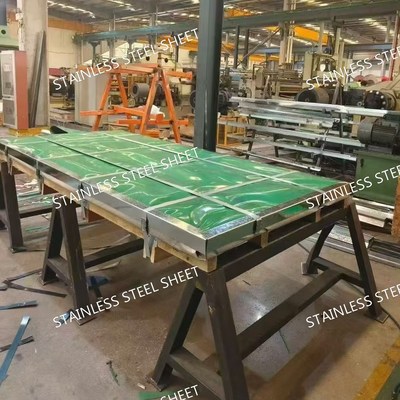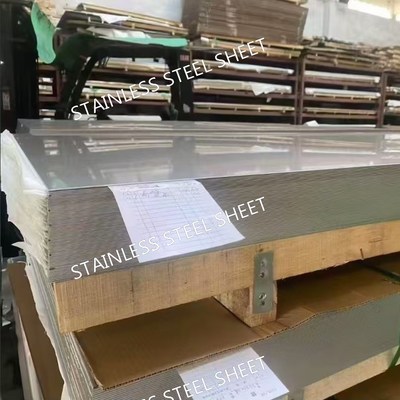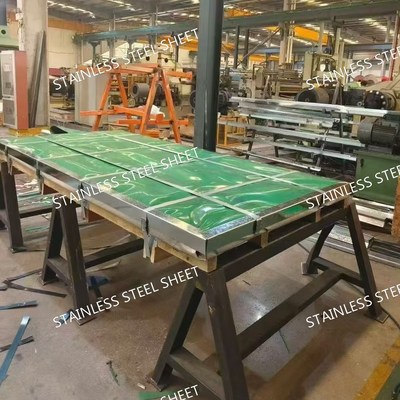모든 제품
-
 라이안 이오네스쿠매우 좋은 소재 품질. 우리는 10년 이상을 협력하게 합니다. 그들은 강철 소재의 다량 종류를 거래합니다. 좋은 모든 소재 품질. 그들 모든 소재 품질을 위한 의무. 우리는 활공하고 있고 계속되고 미래에 그들과 협력합니다
라이안 이오네스쿠매우 좋은 소재 품질. 우리는 10년 이상을 협력하게 합니다. 그들은 강철 소재의 다량 종류를 거래합니다. 좋은 모든 소재 품질. 그들 모든 소재 품질을 위한 의무. 우리는 활공하고 있고 계속되고 미래에 그들과 협력합니다
254SMO 스테인리스강 시트 부식 방지, 고강도 합금 판

무료샘플과 쿠폰을 위해 나와 연락하세요.
왓츠앱:0086 18588475571
위챗: 0086 18588475571
스카이프: sales10@aixton.com
만약 당신이 어떠한 관심도 가지면, 우리가 24 시간 온라인 도움말을 제공합니다.
x제품 상세 정보
| 제품 | 스테인레스 강판 | 등급 | 254SMO |
|---|---|---|---|
| 두께 | 1.0-80.0mm | 기술 | 냉간압연, 열간압연, 단조 |
| 너비 | 1000 밀리미터 1219 밀리미터 1500 밀리미터 또는 요구로서의 세관 | 표면 | 2B BA No.1 |
| 기준 | ASTM GB JIS EN DIN | MOQ | 1톤 |
| 강조하다 | 254SMO 스테인레스 강판,부식 방지 스테인리스 강판,고강도 합금강판 |
||
제품 설명
254SMO 스테인리스강 시트 부식 방지, 고강도 합금 판
스테인리스강 시트 사양
| 이름 | 254SMO 스테인리스강 시트 |
| 당사 등급 |
200 시리즈: 201 202 300 시리즈: 301 304,304L,304H,309S,310S,314,316L,316Ti,316H,316LN,317L,321,329,347 400 시리즈: 409L,410,410S,416,420,430,431,436L.439,441,443,444,445,446 슈퍼 스테인리스강: 904L,926,254SMO,654SMO,15-5PH,17-4PH,17-7PH.etc 니켈 합금: C276, C22,G35,합금 X,Monel 400,K500,Inconel 600,601,617,625,718,Incoloy 800,800H,800HT,825.etc |
| 기술 | 열간 압연, 냉간 압연, 단조 |
| 표준 | JIS, AISI, ASTM, DIN, TUV, BV, SUS 등 |
| 두께 | 0.1 – 80.0mm |
| 폭 범위 | 10mm – 2000mm |
| 길이 | 맞춤형 |
| 마감 | 2B, BA, No.4, 8k, 브러시, 헤어라인, PVD 코팅, 샌드블라스트 |
| 서비스 | 레이저 절단, 벤딩 |
| 샘플 | 사용 가능 |
254SMO 스테인리스강 시트 부식 방지, 고강도 합금 판
부식, 극한 온도 및 기계적 응력이 수렴하는 산업 환경에서 재료 성능은 운영 안전, 효율성 및 비용 효율성을 직접적으로 결정합니다. UNS S31254, EN 1.4547 및 F44로 분류되는 254SMO 스테인리스강 시트는 304 또는 316L과 같은 기존 스테인리스강을 무력화시키는 가장 혹독한 조건에서 번성하도록 설계된 슈퍼 오스테나이트 합금으로 두각을 나타냅니다. 스웨덴의 Sandvik에서 개발한 이 고합금 판은 뛰어난 내식성, 인상적인 기계적 강도 및 다재다능한 가공성을 결합하여 해양 공학, 석유화학, 담수화 등에서 중요한 응용 분야에 적합한 재료로 만듭니다. 이 포괄적인 가이드는 254SMO 스테인리스강 시트의 핵심 특성, 사양, 응용 분야 및 장점을 탐구하여 엔지니어, 조달 전문가 및 프로젝트 관리자가 까다로운 프로젝트에 대한 정보에 입각한 결정을 내릴 수 있도록 돕습니다.
핵심 특성: 재정의된 내식성
254SMO의 결정적인 강점은 가장 파괴적인 형태의 부식에 대한 저항을 우선시하는 고급 합금 조성에 있습니다. 표준 스테인리스강과 달리 254SMO는 고농도의 몰리브덴(Mo), 니켈(Ni), 크롬(Cr) 및 질소(N) 함량의 정확한 균형을 특징으로 하며, 감작 위험을 제거하기 위해 초저탄소(C ≤ 0.02%)로 보완됩니다.
피팅 및 틈새 부식 저항
성능의 핵심은 316L(PRE ≈ 25) 및 2205 듀플렉스 스테인리스강(PRE ≈ 35)을 훨씬 능가하는 ≥ 42의 피팅 저항 등가 수(PRE)입니다. 이 높은 PRE 값은 254SMO가 염화물 농도가 높은 환경(예: 해수, 염수 및 화학 공정 스트림)에 장기간 노출되어도 조기 재료 고장의 가장 일반적인 원인인 피팅 또는 틈새 부식이 발생하지 않음을 의미합니다. 염화물 농도가 극심한 수준에 도달할 수 있는 해수, 해양 플랫폼 및 담수화 플랜트에서 254SMO는 수십 년 동안 구조적 무결성을 유지하여 몇 달 안에 열화되는 기존 합금을 능가합니다.
응력 부식 균열(SCC) 저항
염화물 유도 응력 부식 균열은 고압, 고온 산업 환경에서 주요 위협입니다. 254SMO의 합금 설계(오스테나이트 안정성을 위한 고니켈 및 강화성을 위한 질소)는 주기적 응력 및 공격적인 화학 물질 노출에서도 SCC에 매우 강합니다. 따라서 석유화학 정유소 및 烟气脱硫 (FGD) 플랜트와 같이 온도 변동 및 부식성 매체가 SCC에 완벽한 조건을 만드는 열교환기, 압력 용기 및 배관 시스템과 같은 구성 요소에 이상적입니다.
균일 부식 저항
국부 부식 외에도 254SMO는 광범위한 공격적인 매체에서 우수한 균일 부식 저항성을 나타냅니다. 산화성 산(질산, 황산), 환원성 산(염산, 인산) 및 유기산(아세트산, 포름산)뿐만 아니라 알칼리성 용액 및 산업용 화학 물질에서도 안정적으로 작동합니다. 이러한 다재다능함으로 인해 더 비싼 니켈 기반 합금(예: 합금 625) 및 티타늄을 많은 응용 분야에서 대체하여 더 비용 효율적인 가격으로 유사한 성능을 제공할 수 있습니다.
기계적 특성: 강도가 인성을 충족합니다.
254SMO는 단순히 내식성 합금이 아니라 정적 및 동적 하중 모두에서 내구성을 보장하는 인상적인 기계적 강도와 연성을 제공합니다. 이러한 특성은 固溶 열처리(1040–1100°C 급냉)를 통해 최적화되어 미세 구조를 개선하고 강도와 내식성을 모두 향상시킵니다.
주요 기계적 성능 지표
| 속성 | 사양(용액 어닐링) |
|---|---|
| 인장 강도 | ≥ 620 MPa(최소); 일반 650 MPa |
| 항복 강도(0.2% 오프셋) | ≥ 300 MPa(최소); 일반 320 MPa |
| 연신율 | ≥ 35% |
| 브리넬 경도(HB) | ≤ 270 |
| 밀도 | 8.0–8.1 g/cm³ |
| 융점 | 1320°C |
| 작동 온도 범위 | -50°C ~ 300°C |
합금의 높은 인장 강도와 항복 강도는 하중 지지 구성 요소에 적합하며, 뛰어난 연신율(≥ 35%)은 제작 중 유연성을 보장하고 저온 환경에서 취성 파괴에 대한 저항성을 보장합니다. 극저온 응용 분야 또는 고압 시스템에 사용되든 254SMO는 인성과 구조적 안정성을 유지하여 치명적인 고장 위험을 최소화합니다.
일반적인 스테인리스강과 비교한 강도
316L 및 2205와 같은 널리 사용되는 등급과 비교할 때 254SMO는 강도와 내식성의 우수한 균형을 제공합니다.
| 합금 등급 | 인장 강도(MPa) | 항복 강도(MPa) | PRE 값 | 염화물 저항 |
|---|---|---|---|---|
| 316L | 485–655 | ≥ 170 | ≈ 25 | 보통 |
| 2205 듀플렉스 | 620–850 | ≥ 450 | ≈ 35 | 우수 |
| 254SMO | ≥ 620 | ≥ 300 | ≥ 42 | 우수 |
2205 듀플렉스강이 더 높은 항복 강도를 제공하지만 254SMO의 훨씬 더 높은 PRE 값은 염화물이 풍부하거나 부식성이 높은 환경에서 명확한 선택입니다. 내식성과 구조적 강도가 모두 필요한 응용 분야의 경우 254SMO는 타의 추종을 불허하는 신뢰성을 제공합니다.
화학적 조성: 성능 뒤에 숨겨진 과학
254SMO의 뛰어난 특성은 국제 표준(ASTM A240, EN 1.4547, GB/T 3280)을 준수하는 정밀하게 제어된 화학적 조성에 직접 기인합니다. 다음 표는 주요 합금 원소의 공칭 및 허용 범위를 간략하게 설명합니다.
| 원소 | 함량 범위(질량 백분율) |
|---|---|
| 탄소(C) | ≤ 0.02% |
| 망간(Mn) | ≤ 1.0% |
| 실리콘(Si) | ≤ 0.8% |
| 크롬(Cr) | 19.5–20.5% |
| 니켈(Ni) | 17.5–18.5% |
| 몰리브덴(Mo) | 6.0–6.5% |
| 질소(N) | 0.18–0.22% |
| 인(P) | ≤ 0.040% |
| 황(S) | ≤ 0.030% |
| 세륨(Ce) | 0.03–0.08% |
| 철(Fe) | 균형 |
각 원소는 합금의 성능에 중요한 역할을 합니다.
- 크롬과 몰리브덴은 표면에 조밀한 보호 산화물 층을 형성하여 부식성 물질이 모재에 침투하는 것을 차단합니다.
- 니켈은 오스테나이트 미세 구조를 안정화하여 연성과 인성을 향상시킵니다.
- 질소는 강화제로 작용하여 연성을 손상시키지 않고 인장 강도와 항복 강도를 증가시킵니다.
- 초저탄소 함량은 열처리 또는 용접 중에 크롬 탄화물이 형성되는 것을 방지하여 입계 부식 위험을 제거합니다.
사양 및 사용자 정의 옵션
254SMO 스테인리스강 시트는 다양한 크기, 마감 및 구성으로 제공되어 다양한 산업의 고유한 요구 사항을 충족합니다. 제조업체는 일관성과 품질을 보장하기 위해 엄격한 국제 표준을 준수하며, 특수 프로젝트에 대한 사용자 정의 옵션을 제공합니다.
표준 사양
| 매개변수 | 범위 |
|---|---|
| 두께 | 0.1 mm – 300 mm |
| 폭 | 50 mm – 3500 mm |
| 길이 | 1 m – 12 m(맞춤형 길이 사용 가능) |
| 표준 크기(mm) | 1000×2000, 1220×2440, 1500×3000, 2000×4000 |
| 표면 마감 | 열간 압연(HR) 산세 및 어닐링(No. 1), 냉간 압연(CR) 2B, 2D, 광휘 어닐링(BA), 새틴, 광택 |
| 표준 준수 | ASTM A240, ASME SA240, EN 1.4547, UNS S31254, GB/T 3280 |
| 인증 | 밀 테스트 인증서(MTC), 화학 및 기계적 특성 보고서 |
사용자 정의 기능
고유한 요구 사항이 있는 프로젝트의 경우 254SMO 시트는 다음 측면에서 사용자 정의할 수 있습니다.
- 특정 장비 설계를 위한 비표준 두께(0.15 mm – 300 mm) 및 치수.
- 미적 또는 기능적 요구 사항에 대한 특수 표면 마감(예: 미러 폴리싱, 브러시).
- 폐기물을 최소화하고 현장 처리 시간을 줄이기 위한 맞춤형 절단 서비스.
- 용접부의 내식성을 유지하기 위한 권장 Ni 기반 용접 소모품(예: 합금 625, ERNiCrMo-3)을 포함한 용접 및 제작 지원.
산업 응용 분야: 254SMO가 뛰어난 곳
254SMO의 독특한 내식성, 강도 및 가공성 조합은 실패가 선택 사항이 아닌 산업에서 필수적입니다. 다음은 주요 응용 분야입니다.
해양 공학 및 해양
- 해양 플랫폼: 해수 및 염수 스프레이에 노출된 데크 플레이트, 배관 시스템 및 구조 부품.
- 조선: 선체 클래딩, 밸러스트 탱크 및 해수 냉각 시스템.
- 해저 장비: 고압, 고염화물 환경에서 작동하는 매니폴드, 커넥터 및 라이저.
담수화 플랜트
- 역삼투(RO) 시스템: 농축 염수를 처리하는 압력 용기, 멤브레인 및 배관.
- 해수 흡입 및 배출 시스템: 생물 오염 및 염화물 부식에 강한 구성 요소.
석유화학 및 화학 처리
- 정유소: 원유 처리 및 산 회수를 위한 열교환기, 응축기 및 배관.
- 화학 반응기: 황산, 염산 및 염소화 용매와 같은 공격적인 매체를 처리하는 용기.
- 배연 탈황(FGD): 부식성 SO₂ 부산물에 노출된 덕트, 스크러버 및 미스트 제거기.
식품 및 제약 가공
- 산성 식품(예: 토마토, 감귤류) 및 부식성 세척제를 가공하기 위한 장비.
- 제약 제조: 고순도 및 살균 화학 물질에 대한 저항성이 필요한 용기 및 배관.
펄프 및 제지 산업
- 부식성 화학 물질(예: 이산화 염소, 가성 소다)을 처리하는 소화조, 표백 공장 및 회수 보일러.
기존 합금에 비해 장점
표준 스테인리스강 또는 더 비싼 재료보다 254SMO를 선택하면 몇 가지 주요 이점이 있습니다.
우수한 내식성
- 염화물이 풍부한 환경에서 316L 및 2205보다 성능이 뛰어나 유지 관리 비용을 절감하고 서비스 수명을 연장합니다.
- 많은 응용 분야에서 값비싼 부식 억제제 또는 보호 코팅의 필요성을 제거합니다.
비용 효율성
- 더 낮은 비용으로 유사한 성능을 제공하여 니켈 기반 합금(예: 합금 625) 및 티타늄의 실행 가능한 대안으로 사용됩니다.
- 긴 서비스 수명과 조기 고장에 대한 저항성으로 인해 가동 중단 시간과 교체 비용을 줄입니다.
다재다능한 가공성
- 적절한 소모품으로 우수한 용접성으로 복잡한 제작이 가능합니다.
- 허용 가능한 냉간 및 열간 가공 특성으로 벤딩, 성형 및 가공이 가능합니다(더 높은 강도에 적합한 공구 사용).
온도 전반에 걸쳐 안정적인 성능
- 극저온 조건(-50°C)에서 인성을 유지하고 최대 300°C의 고온 응용 분야에서 안정성을 유지합니다.
- 빈번한 온도 변동이 있는 시스템에서 열 피로에 저항합니다.
설치 및 유지 관리 지침
254SMO 스테인리스강 시트의 성능과 서비스 수명을 최대화하려면 다음 주요 지침을 따르십시오.
용접 방법
- 합금의 내식성에 맞게 Ni 기반 용접 소모품(예: ERNiCrMo-3, 합금 625)을 사용하십시오.
- 용접으로 인한 감작을 제거하고 재료의 미세 구조를 복원하기 위해 용접 후 열처리(1100°C에서 용액 어닐링 후 수냉)를 수행합니다.
가공 팁
- 254SMO는 강도가 높기 때문에 316L보다 가공하기 어렵습니다. 고속강(HSS) 또는 초경 공구를 날카로운 절삭날과 함께 사용하십시오.
- 작업 경화를 방지하기 위해 적절한 윤활과 적당한 절삭 속도를 적용하십시오.
청소 및 유지 관리
- 순한 세제 또는 스테인리스강 세척제를 사용하여 표면 오염 물질(오일, 그리스, 용접 스패터)을 즉시 제거하십시오.
- 보관 또는 설치 중 탄소강과의 접촉을 피하십시오. 이는 갈바닉 부식을 유발할 수 있습니다.
- 부식 또는 기계적 손상의 징후를 조기에 감지하기 위한 정기적인 검사(시각 또는 비파괴 검사).
결론
254SMO 스테인리스강 시트는 슈퍼 오스테나이트 스테인리스강 기술의 정점을 나타내며, 가장 까다로운 산업 응용 분야에 타의 추종을 불허하는 내식성, 안정적인 기계적 강도 및 다재다능한 가공성을 제공합니다. 염화물이 풍부한 환경, 공격적인 화학 물질 및 극한 온도를 견딜 수 있는 능력은 니켈 기반 합금 및 티타늄의 비용 효율적인 대안이 되어 유지 관리 감소, 가동 중단 시간 최소화 및 서비스 수명 연장을 통해 장기적인 가치를 제공합니다.
![]()
![]()
![]()
![]()
추천된 제품




